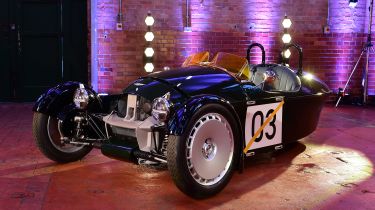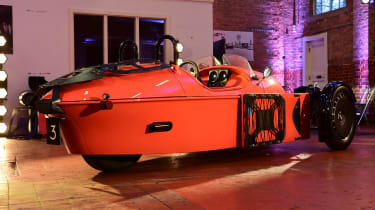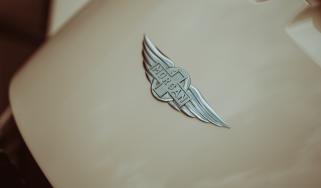New Morgan Super 3 revealed as Ford-powered 3 Wheeler successor
The Super 3 continues Morgan’s 113-year lineage of three-wheelers with a 118bhp Ford engine, a revamped design and a new monocoque chassis
Morgan is bringing its iconic 3 Wheeler into the modern age with this: the Super 3. The new car swaps the previous version’s V-twin motorcycle engine for a 1.5-litre three-cylinder Ford engine with almost 50 per cent more power, and it’s the first ever Morgan built using a monocoque chassis. The Super 3 is on sale now in the UK – prices start at £41,995 for the base car, although an extensive customisation programme could easily inflate this figure.
The previous 3 Wheeler was characterised by its snorting V-twin motorcycle engine, but stringent emissions regulations made it infeasible to continue with such a powerplant. As a result, Morgan has adopted a 1.5-litre three-cylinder from Ford for the Super 3, which has dictated much of the new, ground-up design.
While the teardrop shape, spindly tyres and exposed mechanicals are familiar, the Super 3 has been modernised in certain areas with smoother, concave body surfacing and aerodynamically-optimised 20-inch wheels. Of course, the front-mounted v-twin engine is conspicuous in its absence, too, with the Super 3’s cast aluminium structure on show in its place.
The motorcycle engine was air cooled, and the new water cooled Ford unit has necessitated fitment of radiators on either side of the body. Morgan’s designers have embraced these as design features, by fitting large rectangular side blades behind the front wheels to house them. These can be used to mount luggage racks for longer road trips, and contrasting colour side blades with additional decals are available too.
Instead of the 3 Wheeler’s large side-mounted exhaust system, the Super 3 features a neater ‘exhaust cannon’ cutting through the rear of the bodywork. A new windscreen (available with a yellow tint) has also been fitted for less buffeting at speed, although buyers can do without it and don a pair of goggles instead.
The rear end is more elegant than before with a boat-tail style design, and there’s a small storage area beneath the clamshell boot lid, along with the option of a rear-mounted luggage rack.
As with the previous model, the Super 3’s interior is as much a part of the exterior, and IP64 certification ensures that it’s resistant to dust and water splashes. There’s a pair of gauges in the centre of the dashboard, which are fully digital for the first time in a Morgan and available in either a black or silver anodised finish. The distinctive ‘missile release’ style engine start switch remains, while the seats can be trimmed in various vinyl, fabric and leather upholstery options.
Morgan has installed a new footwell heater, too, and the Super 3 features an optional Beeline smartphone-linked navigation system with a small circular screen behind the steering wheel. The steering wheel itself is adjustable, as is the pedal box.
Morgan claims that the new monocoque design allows for a lighter and more rigid chassis construction, along with improved safety and cabin space. Parts of the structure are made from superformed aluminium, which the brand says is a first in the industry.
At the front, pullrod suspension and a set of lengthened wishbones have been fitted for better ride and handling, and the engine has been mounted behind the front axle for improved weight balance. The rear wheel is suspended by twin trailing arms with two spring and damper units.
Morgan has collaborated with Avon to produce bespoke Speedmaster front tyres for the Super 3, while the rear wheel uses an off-the-shelf winter tyre, chosen for its approachable sliding characteristics – particularly important given the new car’s significant increase in power.
The 1.5-litre engine sends 118bhp and 150Nm to the rear wheel using a belt drive, bringing the Super 3 from 0-62mph in around 7 seconds and onto a top speed of 130mph. The bulkier powerplant means that the Super 3 is slightly heavier than before at 635kg (dry), but the new engine can still return an impressive 40mpg, claims Morgan.
Morgan has tuned the acoustic and vibrational properties of the engine to make it more characterful, and promises a buzzing three-cylinder rasp higher up in the revs. The motor is paired to a five-speed gearbox borrowed from the Mazda MX-5, which is also used in the outgoing model. The car’s bevel box has been re-engineered to reduce whine at cruising speeds, while retaining the mechanical noise of a straight-cut gearbox.
The Super 3 offers more scope for personalisation than any other Morgan, with accessory rails for bespoke luggage, helmet mounts and cameras available. Painted aluminium panniers can also be specified, along with various graphics packs and liveries. The Super 3 is on sale now in the UK, priced from £41,995 with first deliveries in June.
Q&A with Jonathan Wells, Morgan's head of design
Q: The Super 3 ditches the V-twin engine that defined the 3 Wheeler for a conventional car engine. How have you captured that 3 Wheeler character using the new engine?
A: Character was absolutely core to everything here, and we wanted to have the equivalent amount of excitement and character translated from the engine. After looking extensively at engine options from the motorcycle world, we quickly realised that modern motorcycle engines tend to have integrated gearboxes, and that brings challenges such as splicing in a reverse gear and getting used to a sequential gearbox. We quickly realised that this wasn’t the right way to go, so we looked at car-derived powertrains. These aren’t uncommon to Morgan, and early three-wheelers often had car-derived powertrains. So we started with the engine, and we knew that dynamically, it needed to live behind the centreline of the front wheels. That dictates the proportions of the design, so the car looks like it’s being towed by the front wheels, rather than it being sat on top of them.
Q: The old 3 Wheeler used a tubular frame chassis, but the Super 3 uses a monocoque design. Can you explain the change?
A: This is Morgan’s first-ever monocoque. Typically, our chassis are structural and house the wet-works, electronics and they’re core to crash safety and rigidity. The bodies are then coach-built over a wooden frame, and dropped on top of that. This is the first time where the body is structural with a Morgan, making it our first monocoque.
Q: Why did you choose to fit a winter tyre at the rear?
A: At the front, we have wheels and tyres that are completely unique to us. The car has grown slightly, requiring us to change the size of the front wheels so that they look proportionally correct. At the front we’re using a 20-inch tyre developed for us by Avon, and at the back we have a car-derived tyre which is wider for a bigger contact patch, since that’s where the power is put down. We’ve opted for a winter tyre on the back because of its slip characteristics, and that’s all part of getting the handling and character exactly as we wanted it – very playful, very nimble and a lot of fun to drive on the throttle.
Q: Inside, the Super 3 has quite an advanced infotainment system – for a Morgan. Talk us through the tech.
A: “For a Morgan” is key here! It’s the first time we’ve installed a sat-nav system inside a car. We’ve used a lovely device called a Beeline Moto, which is aimed at the motorcycle world. It features a very simple interface, with a countdown and a directional arrow – when the countdown reaches zero, you turn where the arrow is pointing. It’s driven by Google Maps so it’s up to date, and it’s about giving the driver the information they need and nothing more.
Q: For someone that has experienced the previous 3 Wheeler, what are the biggest changes they’ll notice while driving the Super 3?
A: Primarily, the old V-twin that sat at the front of the 3 Wheeler stole the show. You see the engine, and the car strapped to it, and you don’t really look past the engine. The side exhausts, the noise, it was full of character. It was brilliant for a blast around on a Sunday afternoon. The Super 3 is a very different proposition – this engine is much more powerful, much smoother, it’s very exciting high in the revs and it’s got a rasp and that three cylinder warble. If the old one was a scrambler-style motorcycle, this is more of an adventure bike. It’s designed for effortless touring, and for fun, lightweight sports car driving appeal. I’d almost encourage people to drive both vehicles, rather than one or the other, but if it was my choice I’d have the Super 3 – you can spend real time in it and enjoy every second.
Now click here to check out our review of the new Morgan Plus Four…
Find a car with the experts












